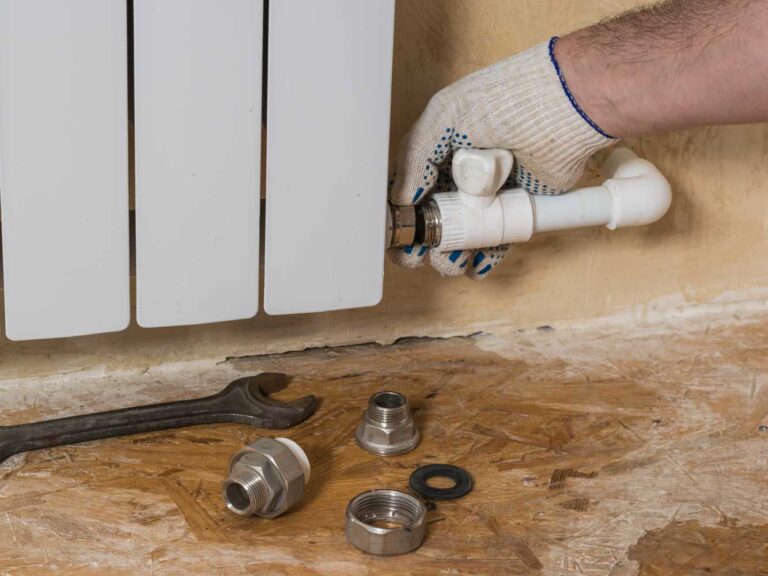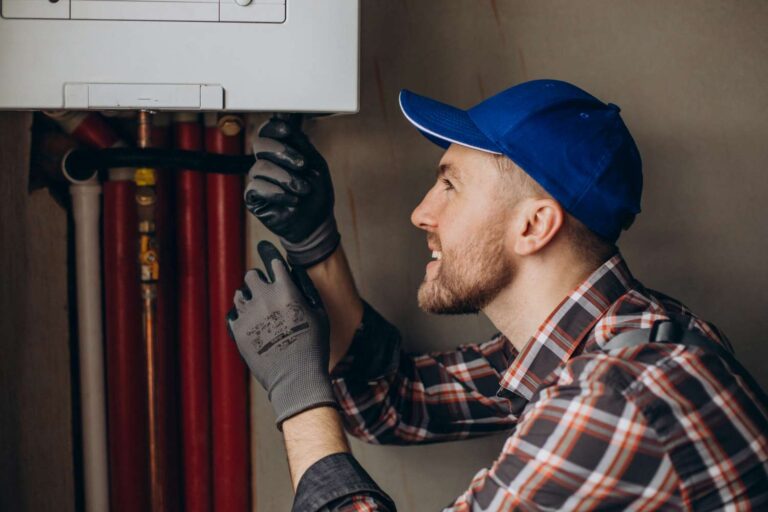- 17 September 2024
- 4 min read
Repair of a leaky overflow pipe – how to do it?

Table of contents
Why is my overflow pipe leaking?
An overflow pipe leaking can be a sign of various issues within your plumbing system. Here are some common reasons why your overflow pipe might be leaking:
- Faulty float valve – in tanks and toilets, a float valve controls the water level. If it malfunctions, it may allow water to rise too high, causing the overflow pipe to discharge excess water.
- High water pressure – excessive water pressure can cause the tank to fill too quickly, leading to an overflow. This can be due to a malfunctioning pressure regulator.
- Worn out washers or seals – over time, washers and seals can degrade, causing leaks around connections. This deterioration can result in water escaping through the overflow pipe.
- Blockages – blockages in the system, such as debris in the float valve or the tank, can prevent the proper regulation of water levels, leading to overflow.
- Thermal expansion – in hot water systems, water expands when heated. If the expansion isn’t managed properly, it can lead to water being discharged through the overflow pipe.
- Aging or damaged components – older plumbing systems or components may become less efficient or damaged, causing leaks. Regular maintenance can help identify and replace aging parts before they fail.
- Incorrect installation – if the overflow pipe or related components are not installed correctly, it can result in improper functioning and leaks.
Identifying the exact cause of the leak involves inspecting the overflow pipe, float valve, and related components. Addressing these issues promptly can prevent water damage and ensure your plumbing system operates efficiently. If you’re unsure about diagnosing or fixing the problem, it’s advisable to seek professional help to avoid further complications.
Tools and materials needed for the repair
To perform a leaking overflow pipe fix, you’ll need the following tools and materials:
- Adjustable wrench – for tightening and loosening fittings.
- Pipe repair tape – to seal minor leaks.
- Waterproof sealant – for sealing joints and cracks.
- Pipe cutter or hacksaw – to cut the pipe if replacement is needed.
- Replacement pipe section – if the damaged section needs replacing.
- Pipe connectors and clamps – for securing new pipe sections.
- Bucket and towels – to catch and clean up any water spills.
- Screwdriver – for removing and tightening screws on pipe fittings.
Having these tools and materials ready ensures a smooth and efficient repair process.
Step-by-step guide to fixing a leaky overflow pipe
Fixing a leaky overflow pipe involves a few straightforward steps. Here’s a step-by-step guide to help you repair it:
- Identify the leak – locate the source of the leak. Overflow pipes typically connect to toilets, water tanks, or boilers.
- Turn off the water supply – before starting any repairs, turn off the water supply to prevent further leakage. This can usually be done via the main shut-off valve or a dedicated valve near the tank or boiler.
- Drain the system – empty the tank or boiler by flushing the toilet or opening the drain valve, ensuring no water remains in the system. Use a bucket and towels to catch and clean up any water spills.
- Inspect the pipe – check the pipe and its connections for cracks, loose fittings, or other damage. Tighten any loose fittings with an adjustable wrench.
- Seal small leaks – for small leaks, apply pipe repair tape or a waterproof sealant around the damaged area. Ensure the surface is clean and dry before application.
- Replace damaged sections – if the pipe is cracked or severely damaged, you may need to replace the affected section. Measure and cut a new piece of pipe to fit using a pipe cutter or hacksaw. Use appropriate connectors and pipe clamps to join the new piece with the existing pipe, securing the connections tightly.
- Reconnect the pipe – reattach the overflow pipe to the tank or boiler. Ensure all connections are tight and secure, using an adjustable wrench or screwdriver as needed.
- Turn on the water supply – slowly turn the water supply back on and check for any leaks. Monitor the repaired area for a few days to ensure the fix holds.
- Professional help (optional) – if the leak persists or if you’re unsure about the repair, it’s best to hire a professional plumber. They can provide a thorough inspection and ensure a proper fix.
Tips for preventing future leaks
To prevent future leaks in your overflow pipe, conduct regular inspections of your plumbing system to identify any early signs of wear or damage. Proper maintenance of key components, such as float valves and pressure regulators, is essential to ensure they function correctly. Using high-quality pipes and fittings during installations can significantly reduce the risk of leaks. Additionally, insulating pipes helps protect them from extreme temperatures, which can cause cracking. Scheduling annual inspections by a professional plumber can help catch potential issues before they become serious problems. These proactive measures help maintain a leak-free plumbing system.
You might be interested in...
- Plumbing advice

17 September 2024
Reasons of a leaking radiator – this is what you need to know!
A leaking radiator can result from several common issues. Corrosion is a major cause, as rust can create holes or weaken the metal. Loose or damaged valves are another culprit, often due to wear and tear. The bleed valve, if not properly tightened, can also leak. Cracks or splits in the radiator body, caused by physical damage or manufacturing defects, can result in leaks. Additionally, joint or pipe connections may become loose or degrade over time. Regular maintenance and inspections can help identify and address these issues early, ensuring your radiator functions efficiently and leak-free.
- Building advice
- DIY

17 September 2024
Mounting your TV on the wall – all what you need to know!
Mounting your TV on the wall offers a sleek, space-saving solution, but it requires proper planning and execution. From selecting the right mount type and ensuring VESA compatibility to finding the perfect spot and safely installing the bracket, each step is crucial. This guide covers everything you need to know, including tools, installation steps, cable management, and troubleshooting tips, ensuring a secure, stylish setup for your home.
- Plumbing advice

17 September 2024
Upgrading to a condensing boiler – what you need to know?
Upgrading to a condensing boiler can be a significant home improvement decision that offers numerous benefits, including increased energy efficiency, reduced heating bills, and a lower carbon footprint. What is a condensing boiler? Condensing boilers are designed to capture heat that would otherwise escape out of the flue of traditional boilers. They achieve this through a heat exchanger system, which condenses the steam generated during the heating process back into water. This process releases latent heat, which is then used to heat your home.